The Hey Hey Hundred
The 16K ZX Spectrum was definitely the ginger stepchild of the family of micros that defined home computing in the UK in the 1980s. With far less memory available to coders (just 9K) than a 16K ZX81, the £125 cost of the entry-level model – shockingly the equivalent of £416 now – didn’t get you all that much bang for your buck when it launched, even by the standards of April 1982.
The vast majority of purchasers wisely chose to save up the extra £50 for the 48K version (£175, or a hefty £582 in 2023 money, although still peanuts compared to the Commodore 64’s launch price of £1,327 equivalent), and the 16K Speccy very quickly fell out of favour. In fact it was withdrawn from sale after barely over a year on the shelves, with old stocks cleared at £99.
(There are no official figures for how many of the 5 million Spectrums sold were 16Ks, but Home Computing Weekly reported in May 1983 that 300,000 machines in total were sold in the first year, and in August 1983 Popular Computing Weekly reported that the 48K had outsold the 16K by two to one, so we can make a reasonable guess at somewhere between 120,000 and 150,000 units of the 16K in the year and a bit it was on sale, or roughly 3% of all Spectrums.)
But even in its very brief life (the vast bulk of these titles were released in 1983), the 16K machine amassed a library of fun games that left the catalogues of many better-specced computers in the dust. And for no particular reason other than that 40 years have passed since it abruptly met its fate, we’re here to celebrate them.
So sit yourself down with one of the last cans of Lilt (or don’t, because it’s full of poisonous artificial-sweetener chemicals now), get ready to fondly remember a few old favourites, and hopefully also discover some lost gems for the first time.
TECHNICAL NOTE: This chart was a real pain to compile due to the generally very poor documentation of all aspects of the 16K Speccy, not just its sales figures. The ZX Database, on which World Of Spectrum and Spectrum Computing are based, is all over the place when it comes to the baby machine.
Lots of games which would likely have made the list are billed as 16K-compatible but aren’t (eg Push Off, Road Racers, Thrusta and Magic Carpet). We’re not sure why this is the case – most of them claimed on their boxes to run on any Spectrum, but they all crash on multiple emulators set to 16K mode unless you use .Z80 snapshot files, in which case they force the emulator into 48K mode whatever you set it to. Sadly we don’t have an actual 16K Spectrum with which to definitively establish the truth.
(Bizarrely some great games actually written in just 1K of memory also don’t run on the 16K because of the memory location that their coders chose to put them in.)
Many more, conversely, are listed as 48K titles but actually run perfectly happily in 16K, and you’ll read about some of them below (because hey, no spoilers). Every game in this list is verified genuinely 16K-friendly.
100. HAUNTED HEDGES
(Micromega, 1983)
A nice-looking straight-up Pac-Man, with variable ghost intelligence, that gets up to a pretty zippy speed after a level or two. You can’t turn your back on the classics.
SEMI-FUN TRIVIA FACT! Atarisoft’s official release of Pac-Man also ran in 16K, but we included Haunted Hedges instead because it’s got a bit more variation and it’s prettier. The spot WOULD have gone to Pac-Hack, a 2021 mod of the Atarisoft release which squishes the maze horizontally until it’s much more like the coin-op and results in a much more fun and exciting game, but because it was only released as an SZX file (a 48K snapshot) we can’t be sure it still works on a 16K machine.
99. SHADOWFAX
(Postern, 1983)
Mike “Lords Of Midnight” Singleton’s early Speccy games didn’t have to worry about squeezing into 9K of memory, because most of them were originally written for the unexpanded VIC-20, which had an even teenier 3.5K of RAM available. Even on the relatively roomy Speccy they stayed hyper-minimalist, with a front end that consisted of pressing S to start.
Shadowfax only does one thing – you tackle an endless charge of beautifully-animated demon riders with a lightning bolt you have to detonate manually at the right moment – and it seems like you should be able to beat it indefinitely, but its genius is that it gives you just one life, so that you’re always just a moment’s loss of concentration away from a game-ending disaster.
SEMI-FUN TRIVIA FACT! The Spectrum and C64 versions put your horse on the right of the screen galloping left, while the BBC and VIC versions do the opposite.
98. OH MUMMY!
(Gem, 1984)
This unassuming Amidar ripoff has been oddly enduring, still being released on new platforms like the Megadrive well into the 21st century, as well as getting a Spectrum Next port in 2020 and a Speccy remake in 2021.
Gem’s 1984 version for the Spectrum is primitive even when compared to the far smoother and prettier Amstrad original, but it still captures all the action.
97. SIEGE
(Postern, 1983)
Now, in truth this is barely above the level of a magazine type-in game. It made it in mainly for the sheer and persistent satisfaction of causing chain reactions, where you drop a rock on one invader’s head and he takes out others as he plummets to his flaily death. Unlike your mum, it just never gets old.
SEMI-FUN TRIVIA FACT! Unlike the original on the Commodore PET, at least by the time it got to the Speccy version Singleton had managed to spell the name right.
96. GALACTIC JAIL BREAK/COSMIC GUERILLA/COSMIC PLUNDER
(Apocalypse/Crystal/Ediciel, 1983/1983/1984)
Ultimately it would have been churlish to include one of these but exclude the others. All are ports of the obscure 1979 Universal coin-op Cosmic Guerilla, all are fast and smooth and challenging, and all have different pros and cons.
The Apocalypse version (above) is prettier and simpler – and simplifying Cosmic Guerilla is no small achievement – while Crystal’s take is closer to the arcade and offers more gameplay options, but can be a bit easy when you’re down to your last life.
Cosmic Plunder, meanwhile, is a French version (properly called Pillage Cosmique) which was ported from a machine we’d never even heard of before writing this article, called the Alice 32/90, which seems to only ever have had eight games released for it.
It’s arguably the best balanced of the three gameplay-wise, if a little monochromatic.
All of them are actually livelier than the original, though, which is nice.
SEMI-FUN TRIVIA FACT! The original draft of this chart had Galactic Abductors by Anirog – a clone of another obscure coin-op called Stratovox – in this slot, but after some reflection it got subbed off for having annoyingly unreliable hit detection.
95. MONSTERS IN HELL
(Softek, 1983)
The Spectrum got loads of versions of the arcade game Space Panic, but this is one of the most creative and challenging variants on any platform, and also by far the most actually panicky. Unusually, once you’ve dug a hole for the titular Monsters to fall through there’s no way to fill it back in, so you have to be careful not to box yourself into a dead end (as the unfortunate chump in the screenshot has).
You have to constantly run around hell-for-leather luring the beasties into the flames (which is eventually the only way to kill them) while collecting crosses to keep up your fast-diminishing energy, but like life itself, you’ll always fail in the end.
94. SPACE ZOMBIES
(Mikro-Gen, 1983)
A simple but pleasingly-executed space shooter with nice chunky graphics, good control (machine-gunning a column of alien marauders with autofire is very satisfying) and echoes of Space Firebird in the arcades and Megamania on the Atari VCS.
93. APPLE JAM
(DK’Tronics, 1984)
The list of Health & Safety infractions at the DK’Tronics jam factory is a deeply concerning one. Staff are forced to consume large amounts of excess product from poorly-maintained machinery and then sweat it off in an overworked sauna. A stock of pills is on hand in the case of frequent heart attacks. A broken lift sits in a pool of blood and rat corpses, while poison litters the work area and deadly giant killer hornets encroach through the open windows. It’s basically the original Amazon.
Still, the employees always have a smile on their faces. Either they enjoy the simplistic two-button excitement of their non-stop all-action lifestyle, or it’s the drugs.
92. LUNA CRABS
(Micromega, 1983)
Almost worth inclusion just for the sheer audacity of calling itself “3D”, Luna Crabs is also a super-slight but slick sniping game in which you have to carefully pick off a swarm of sinister space crustaceans by isolating one or two from the herd at a time, because if you blunder straight into the pack you’ll be met with a spectacular barrage of phlegmy and deadly crab gob.
91. FROGGY
(DJL, 1983)
The Speccy was (and remains) poorly-served for conversions of Konami’s pseudo-amphibian arcade hit, with the best port weirdly being a 2021 homebrew effort written in BASIC. But despite being a bit uggo DJL’s recreation of its successful ZX81 release gets most of the coin-op features in and does a good job of capturing the general vibe, complete with the crucial intro jingle.
90. CRAZY CAVERNS
(Firebird, 1984)
Sokoban is one of the most boring videogames ever invented, but it turns out that you can make it a lot more fun by throwing a few fast, randomly-moving baddies into the mix and letting you shove whole rows of crates (or in this case sugarcubes) at once. One of the early games from Firebird’s £2.50 budget range and one of the best.
89. GRID-BUG
(Add-On Electronics, 1983)
Initially this looks like a variant of the arcade’s Solar Fox, but on starting a game you quickly discover that it’s a bit cleverer than that.
Your objective is to collect all the hearts, but if you cross an empty box you’ll restore a heart to it, so you have to use the rails in between the boxes, while avoiding a problematically-increasing number of unpredictable and deadly spiders.
It’s one of those games where you can rapidly become your own worst enemy, and it’s always nice to have a worthy opponent.
88. POOL
(CDS Microsystems, 1983)
This isn’t much of a simulation of pool, but what it is is a pretty good port of Konami’s ultra-minimalist 1981 arcade game Video Hustler. It’s simple but very far from easy, and you’ll need some real skill to “rack up” a decent score here!!!!!!!!!!!!!
(Are you on “pot”??!?!??!!?!?!!?!?! – Ed)
87. MOLAR MAUL
(Imagine)
A detailed and accurate simulation of the endless battle against the dastardly and all too real evil of caries, Molar Maul is a game played in almost total silence, which at first seems like a major drawback until you think about how traumatising it would be if it was accompanied by dental-surgery noises. And when you consider how tiny that airline toothpaste tube is, it’s no wonder it’s so hard to amass a decent score before you end up like Shane MacGowan.
86. A WORLD OF ONE WAY
(Serdjuk, 2021)
As far as we know there’s no generic name for the quite common type of game where you’re apparently standing on a surface of waxed Teflon and can only stop moving, once you start, by smacking into a wall.
So we’re going to call them “slippy-slidey maze puzzlers”, and this is a pretty and very tricky one. It’s also a bit meta, in that you have to use the money you earn from beating levels to buy extra lives or passwords, a slightly odd design choice in a 2021 release that’s mostly going to be played on emulators with savestates, but there you go.
85. STAR WARRIOR
(Visions, 1983)
It’s always nice to mix things up a bit, and this three-stage space odyssey (shoot the aliens, make a landing through a meteor shower and loot a diamond from a maze) fits the bill nicely. Like going to a dim sum restaurant, each part is pretty slight in itself but by the time you’ve been round them all a few times you’ll be full up and burping little bits of game flavour all night.
84. ARMAGEDDON aka TERRA FORCE
(Fashionsoft/Firebird, 1983)
A speedy and hard Centipede derivative in which you also have to stop space demons from eating the Moon. Like, what more do you want? (Difficulty is a feature that will crop up a lot in this chart, because when you didn’t have enough memory to write a lot of game, you had to give it a lifespan by at least making it tough to beat.)
Gridrunner by Jeff Minter is worthy of an honourable mention here as another 16K Centipede-with-a-twist, but Armageddon is just a bit more interesting, plus it’s kinda embarrassing when the Speccy version of something is inferior to the VIC-20 one.
83. MAGIC MEANIES
(CDS Microsystems, 1983)
It might have the UDG graphics of a magazine type-in, but crank up the speed (it offers options from sedate to super-ultra-turbo) and ignore the extra-specially ugly first level and this uber-primitive knock-off of Mr Do! has plenty going for it.
It’s got jaunty music, constantly introduces new enemy types and if nothing else you’ll keep playing it just to see the new background tile in each new level. It gets less and less like Mr Do! as it goes on (there’s actually a little bit of Solar Fox in there), but you’ll need to be good to find that out.
SEMI-FUN TRIVIA FACT! Magic Meanies is spookily similar to a Blaby game from the same year called Gold Digger. Nobody knows which one came first or if they’re by the same author (Gary Capewell wrote Gold Digger, Magic Meanies is uncredited), but Gold Digger is a little more primitive – no music, no magic ball, same background tile throughout – so if there’s been any borrowing going on we suspect it’s the original.
82. MORRIS MEETS THE BIKERS
(Automata, 1983)
Not enough games are based in multi-storey car parks. With all those levels and stairways and lifts and ramps and barriers and rules, and their grim urban settings, they ought to be a gift to platformers and arcade adventures in particular, but they always get overlooked.
With its psychedelic pulsating floors MMTB looks unlike almost any other Speccy game too, and while a couple of questionable/lazy design choices let it down – it could easily have been 20 places higher otherwise – it’s still clever and fast and tense.
81. GALAXY WARS
(Dancresp, 2013)
Visually one of the most accurate arcade-to-Spectrum ports ever, and the gameplay is as close to perfect a replication as you could hope for on a landscape-format screen too. Even the BASIC version is highly playable, but the significantly faster compiled version is the one we’re listing here.
80. CRAZY BUGS aka BEETLEMANIA
(AWA Software/MC Lothlorien, 1983)
Although it looks at first like it’s going to be really boring, this super-basic maze-chaser really livens up fast, as the speed increases, the maze itself evolves and new types of baddy appear. It’s really smooth and slick too, and with no offensive or defensive weaponry it’s tense and perilous and way more fun than you expect. Escaping a stage really feels like a victory.
79. SHARK ATTACK
(Romik, 1983)
This is notable just for being a 16K Speccy game with continuous music (an almost unique trait), although the word “music” is working very hard there. But it’s also a frantic and addictive arcade game pitched somewhere between Qix and Crush Roller, as you bid to protect vulnerable, immobile octopi from what the game calls “sharks” but are clearly ravenous piranha.
You do this by surrounding them with an “atomic net” then filling as much of the sea with it as possible, like a deranged Greenpeace activist who’s lost the plot and turned into a coked-up marine version of The Punisher. Most of the action happens in the first five seconds of a level and it’s such a mad buzz you can’t wait for the next one.
78. IT’S THE WOOLUF!
(Crystal Computing, 1984)
You can always tell when a coder really really hates their customers, and one of the big giveaways is having 40 keys available on a keyboard for four movement directions but putting them all on the same row and not even including a Kempston joystick option. ZXNM? FML FFS.
But once you fix that problem with a programmable stick or emulator remap, It’s The Wooluf! werewolfs from tediously frustrating to entertainingly frustrating as you try to QUITE LITERALLY shepherd your idiotic and suicidal charges through a hazardous landscape populated by a weirdly-teleporting predator.
77. MISSILE DEFENCE
(Anirog, 1983)
This shouldn’t really be good. An early release from Keith “Space Harrier” Burkhill, it has an awkward handful of control keys, you can only fire one defence missile at a time, and key features of the arcade game (like splitting missiles) are missing.
Yet despite all that (and an ugly score-display bug that kicks in after the 5th stage) it’s still by far the Speccy’s most compelling port of Missile Command, with well-judged difficulty and pleasingly lingery explosions that trigger plenty of chain reactions.
76. HAWKS
(Lotus Soft, 1983)
It might not be much of a looker, but there’s so much going on in this game. It borrows elements from arcade games Phoenix and UniWar S in an incredibly frantic shooter where you have to marshal three separate weapons against two waves of attack, the strength of the second depending on how well you do in the first. Give it a shot and you’ll soon stop noticing the graphics.
75. OSSUARY
(Cyningstan, 2013)
This list has been very action-oriented so far, but now for something completely different – a very pretty 2013 Roguelike with lots of monster-and-treasure-stuffed dungeons crammed into the tiny memory space. The randomisation of your character at the start forces you to play differently every time – sometimes a wizard, sometimes a brute – and there’s limitless entertainment for Rogue fans here.
74. PAINTING JOE
(ERE Informatique, 1984)
Amidar is a simple and classic arcade game that could and should have been done pretty much perfectly on the Spectrum, but never was. The closest anyone got was this French release, which has all three rounds and replicates almost every gameplay feature accurately (including the distinctive enemy movement), and is only slightly let down by rather tatty presentation and the bewildering failure to colour in the blocks on the odd-numbered stages.
It’s still highly playable though, and I’ve translated both the 16K and 48K versions into English, and also produced quick-play snapshots that let you skip the tiresome intro, all of which can be downloaded from here.
SEMI-FUN TRIVIA FACT! While it’s also quite primitive in execution (mainly the sloppy cornering and lack of continuous player motion), Colour Clash by Romik is another not-half-bad 16K replication of Amidar, including all three of the coin-op’s level types. What’s weird is that it also adds a fourth, which for no good reason at all is a variant of the “light cycles” battle from TRON.
(Not pictured here.)
There’s also a much prettier, slicker Speccy take on Amidar in the form of a Spanish magazine type-in called Striker (which has continuous music rather nicer than Shark Attack’s, although it also doesn’t colour in grid squares when you surround them because it has bigger graphics than Painting Joe’s that would cause – hey! – colour clash). But despite only being 5K in size it doesn’t work on a 16K machine. Doh!
And what the heck, while we’re here let’s also tip the hat to Amidar, a Spanish coding competition entry from 2022 that excellently replicates the vintage Gakken tabletop game in compiled BASIC (but sadly, again needs 48K).
73. GALAXIANS
(Artic, 1982)
Well, it’s Galaxian, innit? Probably still the Speccy’s best version, which is a bit of an indictment on those that have followed it, including the 48K official Atarisoft release and a 2021 remake.
72. LORD HARRY
(Lotus Soft, 1983)
This is basically a superior version of Hungry Horace in which you run around the extensive gardens of your mansion, avoiding deadly ponds and some sort of mutated angry pink dogs. You can move freely through the wraparound grid of stages, but you better know where you’re going or you’ll blunder into the drink before you know what’s happening, and the extra space and freedom feels fluid and liberating compared to Horace’s super-restrictive mazes.
71. STYX
(Bug-Byte, 1983)
The debut game of Matthew “Manic Miner” Smith, this cunning single-screen multi-stage shooter presents you with an interesting dilemma – blast your way through the enemies with a laser that gets less powerful the more you use it, or try to dodge your way to the end preserving your firepower for when you really need it?
Your laser recharges for every loop, but the numbers of baddies multiply too, and as their slow-decaying, still-deadly corpses litter the battlefield the decision gets harder and harder.
SEMI-FUN TRIVIA FACT! It’s hard to be certain, but Styx may well have been the first Speccy game to use the iconic QAOPM/Space keyboard layout as its default.
70. ZX PARACHUTE
(Carles Oriol, 2020)
The Speccy’s two-colour graphics are incredibly well-suited to reproducing Game & Watch games, and there have been several ported to the machine. This is probably the pick of the bunch, which is handy as it’s the only one that runs in 16K.
(The main contender, if you’re interested, is Diver: Mystery Of The Deep, which is a beautifully-presented version of Octopus but needs 128K if you want any sound. Oil Panic and Mario Bros have also been converted superbly in 48K.)
Game & Watch games obviously have quite limited replay value, but it’s really cute to have a blast on one now and again for a meta-nostalgia trip within the nostalgia trip of playing Spectrum games in 2023 in the first place.
69. PIGGY
(Spectrum Computing, 1985)
A few buried treasures have been uncovered in the little-explored vaults of tape magazines, and this suitably-underground gem is a real sparkler in the mud.
Ostensibly in the vein of earth-moving games like Dig Dug, Boulder Dash, Mr Do! and The Pit, Piggy has a distinct tactical puzzle element to it, dictated by the unsophisticated chase patterns of the monsters.
Once they get a sight of you they’ll stay doggedly on your tail no matter what, which means that to gather all the loot without getting trapped and chomped you’ll have to think really carefully and lure them away from the goodies in the limited manoeuvering space.
68. COSMIC RAIDERS
(Mikro-Gen, 1983)
Absolutely comically unplayable with the demented control layout that Mikro-Gen were unaccountably obsessed with in 1983 (all number keys, but not the cursor or Sinclair keys, spaced out all across the top row from 2 to 0, with the bottom row split into two halves for extra functions), but magically transformed by emulator remapping into an actually pretty spiffy – if not exactly silky – Defender knockoff.
67. RUN BABY RUN
(Micro Gold/Firebird, 1983)
Another game popularised by Firebird’s £2.50 Silver budget label, Run Baby Run is one of the strangest and most original games ever to grace the rubber-keyed king of micros. You lead a bunch of cop cars on a merry chase around various seedy parts of an unnamed town, trying to induce them to crash into each other by blindly following your trail as you loop round and round the maze.
It takes strategy and memory and dexterity to clear even a single stage, and it’s typical of the untrammeled inventiveness that characterised the 8-bit era of home computing in general and the Spectrum in particular.
66. PINBALL WIZARD
(Sagittarian Software, 1983)
It might not look much, but this is a deceptively engrossing 1950s-style table with challenging tasks to complete and arguably still the best physics of any pinball game on the Speccy (which is admittedly quite a low bar).
65. INVADERS
(Artic, 1982)
Artic’s version was the most authentic-looking of the Spectrum’s rash of early ports of the classic coin-op, and played well with nine speed settings and four Atari VCS-style game variations combining “mutant invaders” and diagonal enemy shots that rebound off the sides. It remained the best Speccy version of Space Invaders right up to a few years ago when the emulated version and Space Invaders ZX showed up.
64. HORACE GOES SKIING
(Psion/Melbourne House, 1983)
It’s a game that asks a lot of questions, like who decided to put a ski-hire shop on the opposite side of a busy road to the slopes, what such a major and insanely congested highway is doing at the top of a mountain in the first place, why you get teleported back from the finish line to the shop and have to cross the road again even though you’ve still got your skis, and whether it’s ethical for a speeding ambulance to run you down and then charge you $10 to take you to the hospital.
Sadly none of those questions are going to be answered in this chart because we’re too busy, but it’s still a fun game.
63. HARD CHEESE
(DK’Tronics, 1983)
Like Piggy and Magic Meanies, this is a game that tries to give the impression of being Mr Do!, isn’t much like Mr Do! at all, but is actually still quite good fun in its own right.
Unlike its arcade parent, there’s only one way to beat a level in Hard Cheese – killing off all the blue meanies. Since there are lots of them, they’re very fast, the levels are quite small and your weapon (some sort of pesticide cloud?) takes a while to charge, the only sensible tactic is to dig yourself a long tunnel (ideally with the entrance blocked by an apple) and try to hide at the end of it, firing whenever you can.
The good news is that the meanies can’t dig, which means that the main danger at that point becomes your pesky pesticide finding its way fatally back to you, which can lead to some comedy Wile E. Coyote antics as you run away from it in a panic.
What all this means in practice is that as with Shark Attack, most of the key action happens in a frantic 10-second burst at the start of a level, which is pretty exciting.
Incidentally, the game comes with no instructions either onscreen or on the cassette inlay, so quite what the jinkies all these monsters, apples, cans of what appear to be Coke and tractor-sized wedges of cheese are doing underground in the first place is a mystery for the ages. Maybe it’s set during the Great Fire Of London or something.
62. JUNGLE TROUBLE
(Durell, 1983)
This single-screen adventure is a real performance game. It’s so hard that at first you think it’s broken, so impossible does it seem to be to even make it past the first stepping stone on a crocodile-infested Amazonian river. But eventually you get a handle on the super-precision timing, and thanks to the exquisite animation of your stickman explorer, bystanders will quickly gather to marvel at the fluid, poetic beauty of your play.
It does let you play at various degrees of slow-mo for training purposes, but a true artist tackles Jungle Trouble at Level 1 all the way, and the satisfaction of finally beating it and enjoying that home stretch (watch out for the surprise!) as all around you cheer and applaud is hard to match.
61. TURBO DRIVER
(B.O.S. Software, 1983)
This is an odd little racer that starts out as an obstacle course and then abruptly turns into a joust with four other cars as you try to preserve enough fuel to reach the finish line at 5120m and then take the chequered flag before any of the others can hit it.
There’s no advantage to driving fast at any point, the maximum length of a game is just over two minutes, and it’s basically not like any racing game you’ve ever played. What really makes it are the bright cartoony graphics and clever use of sound – you’ll HATE collisions so much that those two minutes are a high-tension rollercoaster every time.
60. PSSST!
(Ultimate, 1983)
Generally held by right-thinking people to be the least compelling of Ultimate’s original batch of four Speccy titles – there’s a little bit too much of Diner Dash’s constant-faffing-around energy here, and not enough time spent doing the actual bug-zapping that’s ostensibly the heart of the game.
But the execution and presentation of Pssst! still stood head and shoulders above almost everything else in the early Speccy catalogue, and the payoff of your giant Thyrgodian Megga Crisanthodil bursting into beautiful bloom never gets old.
59. HARRIER ATTACK
(Durell, 1983)
“Scramble, but in the Falklands War” must have been quite the elevator pitch, but this is still by any reasonable measure the most successful game ever to originate on the Oric-1. A great showcase for how much atmosphere you can create with 8×8 UDGs, it’s got a real sense of place and it’s deeply satisfying when you pull off a successful low-level bombing run.
58. TWO-GUN TURTLE
(MC Lothlorien, 1984)
A rip-off of the vector-graphics arcade game Rip-Off, where you defend a crop of vulnerable tomatoes from various pesky critters, with the added difficulty (not present in the coin-op) that your own shots also destroy your precious produce. Seriously tough, TGT would have swallowed 10p pieces at a prodigious rate but you’d have kept coming back.
SEMI-FUN TRIVIA FACT! Your turtle only has one gun.
57. ASTRO BLASTER
(Quicksilva, 1983)
There’s not much to this space shooter very loosely based on the Sega arcade machine of the same name, and which also has some very noticeable echoes of the same author’s Star Warrior from earlier in this chart. But its cycling levels of alien monsters, meteor showers and bosses are intense and relentless and your spaceship is responsive and fast-firing, which makes the quest to see the next enemy species enjoyable and addictive.
56. HORACE AND THE SPIDERS (mod version)
(Sinclair Research, 1983)
We mentioned Space Panic earlier in the Monsters In Hell entry, but where that was a quite distant relative, we also wanted to include an almost arcade-perfect clone, in the form of the splendid Sam Spade by Silversoft. Unfortunately it turned out to be another supposedly-16K game that in fact crashed every emulator we tried unless it was run in 48K mode, so it got disqualified.
Digger Dan by Ocean got ruled out as a replacement for being too boring, so we’ve ended up with Horace And The Spiders (a dozen or so places further down the chart than Sam Spade would have been) – another derivative that plays quite differently to Space Panic around the same basic structure.
The main differences are Horace’s constant movement, your inability to fill in holes (making it a bit more strategic), and the fact that a key gameplay feature of the arcade game – dropping baddies through multiple floors at once – is something to be avoided here, as it just gives you a lot more work to do for no benefit.
All of that would have been fine – vive la difference! – if HATS wasn’t spoiled by two inordinately tedious subgames before every level, but fortunately there’s a modded version that bins them and turns it into something that isn’t as good as Sam Spade, but is still a pretty diverting Panic with a twist. (NOTE: Sheer Panic, Spectral Panic and Super Digger are all cruder versions but worth a look too.)
You can download the fixed version here.
55. RIFLE RANGE
(Mr Chip/Mastertronic, 1984)
This variant on the classic arcade shooting gallery Carnival is a bit more tactical than it looks. To beat a level with your limited ammo supply you’ll have to clear a gap through the three lines of animals, shoot holes in the prize wall, and then wait for it to start spinning before you can safely shoot the prizes that provide you with the crucial extra bullets. As in real life, murdering the stallholder and just nicking the prizes is possible, but a bad idea.
54. DI-LITHIUM LIFT
(Hewson Consultants, 1983)
Some say there is no such thing as true evil, only competing sets of sincerely-held values and unmoderated self-interest. Those people haven’t played Di-Lithium Lift.
Di-Lithium Lift is hatred distilled to a digital essence, a grossly warped exploitation of mankind’s better nature. It is ugly to both the eye and the human spirit. It does not provide you with the necessary tools (in this case, key response speed) to perform the tasks demanded of you. It is a grotesque slur on the game it shamelessly plagiarises – the beautiful Solar Fox again, whose lack of a properly great Speccy version humbles the machine in the face of the C64’s absolutely stunning port.
And yet you will persist, even after your 50th failed attempt at Level 1, for it is his endurance in the face of horror that separates man from the beasts and feeds the soul.
SEMI-FUN TRIVIA FACT! The sheer demented orneriness of Di-Lithium Lift got it the nod in this chart over the very similar – and technically superior in just about every way – Transversion by Ocean.
53. MAZE DEATH RACE (fixed version)
(PSS, 1983/2019)
For 36 years this game just flat-out didn’t work. The unofficial conversion of Namco’s classic Rally-X was afflicted with a disastrous graphical bug that rendered the game unplayable. But a couple of years ago a Hungarian coder finally found and fixed the problem, turning it into the stripped-down but speedy and addictive street chaser it was supposed to be.
52. FIREBIRDS
(Softek, 1983)
In the Speccy’s early days merely being written in machine code rather than BASIC was regarded as impressive enough to count as a selling point, and Firebirds – actually called “Firebird” singular on the start screen – was one of the titles that liked to draw attention to the fact by loading with LOAD “” CODE rather than the standard command.
It was a good enough game not to need the gimmick, though – a zippy and zappy blend of Phoenix and GORF encompassing three rounds of alien-blasting followed by an impressive mothership which arrived on screen with a suitable amount of drama, if also an awkward amount of clumsy and unnecessary colour clash.
SEMI-FUN TRIVIA FACT 1! The impressive mothership is actually stolen wholesale from the Intellivision version of Imagic’s multi-format classic Demon Attack.
SEMI-FUN TRIVIA FACT 2! A prototype version of Firebirds exists, also running in 16K, which has chunkier graphics and bombs falling down the screen in addition to the warbirds’ attacks, but is just the same wave over and over again with no mothership.
SEMI-FUN TRIVIA FACT 3! There’s also a 48K version of Firebirds, but we can’t find any differences between it and the 16K game other than having a slightly simpler version of the mothership (see above).
SEMI-FUN TRIVIA FACT 4! Firebirds was released under two other names – a Spanish release called Phonex which seems to be lost to history other than its boxart:
and on a flexidisc (!) given away with Computer Gamer magazine in 1985 under the name of Xebec. Other than the name, saying “Merry Christmas” on the intro screen and having the 48K mothership, there are no detectable differences.
51. ISHIDO: THE WAY OF STONES
(m/ZX, 2015)
A good-looking port of a Macintosh game with lots of customisation options. It’s a pseudo-puzzler, in that you get dealt tiles randomly and then have to react to whatever comes out, rather than a true puzzle where it’s 100% skill and logic, but the same is true of Tetris and that seemed to do okay.
50. TWILIGHT ZONE
(Thor, 1984)
Looking a bit like Jeff Minter’s Laser Zone, this is a simpler and more frantic twin-axis shooter where you just have to survive an onslaught for a set period of time to move onto the next stage. The keyboard layout is rubbish (IJNM and 0 to fire your Gorf-style abortable laser) but that’s easily fixed in the modern emulator age or with the Kempston joystick option and what’s left is a busy, noisy and absorbing arcade blaster.
49. BOUNCING BERTY
(Power Software, 1984)
Among the Speccy’s many, many attempts at Q*Bert this is one of the least sophisticated, but it’s so insanely, comically manic (you can zip through an entire game in four seconds if you’re not careful) that it has a highly entertaining and addictive quality of its own (helped by an instant restart).
SEMI-FUN TRIVIA FACT! Value for money wasn’t a factor in this chart, but Bouncing Berty was released as a £3.50 double-pack with a pretty respectable Pengo clone called Eskimo Capers that’s also worth a play.
48. TAXI!
(Digital Integration, 1983)
This is a real brain-bender from Jeff “Cruising On Broadway” Naylor. The premise is the same as every taxi-based game ever – pick up passengers and drop them off – but this one takes place in some sort of massive Place De La Concorde-style town square in which people are presumably taking cabs for journeys of less than 100 metres because they’d have no chance of walking across the insanely busy road without getting mown down.
The choice of “in and out” controls rather than four-directional ones might be a bit questionable, but your brain does adjust to it after a short while and you can focus on the brutal, anarchic traffic that would seemingly rather die in a tangle of twisted and crushed metal than either give way or indicate.
47. GALACTIC TROOPER
(Romik, 1984)
Astro Invader is a coin-op the Speccy really should have had a near-perfect conversion of. It would have taken no more effort at all for Ian Morrison and David Anderson to give Galactic Trooper arcade-accurate colours and graphics, given that the 1980 original basically ran on Space Invaders hardware with monochrome sprites and colour clash.
Still, as it stands – especially if you play the version modded to remove some ugly BRIGHT attributes that weren’t noticeable on 1980s CRTs but very much are on modern monitors – it captures every element of the gameplay nicely, and at the top speed it’s a frantic and challenging shooter.
46. SCRAMBLE
(Mikro-Gen, 1983)
As with Cosmic Raiders (by the same author), Mikro-Gen’s version of Scramble is cursed with a ridiculously bad keyboard layout – seriously, what was UP with that guy’s HANDS? – but fix that via emulation or with a programmable joystick and this is a crude but really playable and pretty complete version of Konami’s arcade hit.
It’s basically got all the levels except the tricky “maze” section – which is replaced by an equally challenging hybrid of three of the previous stages – and while it’s on the rough-and-ready side it does a surprisingly impressive job of capturing both the coin-op’s content and feel in the tiny memory space.
45. TROM
(DK’Tronics, 1983)
A really neat little pure action game, of the genre where it looks so simple that you keep acting recklessly and getting killed. Snakes and snipers attempt to interfere as you collect objects from around the screen and drop them into the central furnace and that’s it, but at skill level 1 it’s fraught from the word go.
44. TARDIGRADE
(Stonechat Productions, 2021)
We’ve been long overdue a game about one of the planet’s most astonishing animals, and the almost-indestructible pico-bug has certainly been done proud here in a very smooth challenge of intricate manoeuvring in which, like Jungle Trouble, the highly-skilled player can pull off a display that’ll have onlookers cooing and applauding.
43. PENGY
(Micromania, 1983)
There were a lot of Spectrum ports of Pengo, and a fair few in 16K, but this fast and full-featured effort really nails the coin-op vibe as you’re harassed mercilessly from the opening seconds by a swarm of snow-bees, to the point where you don’t even miss the jaunty music. Slightly sharper control response would have moved it further up the chart, but it’s highly playable as it is.
42. ED-ON
(Add-On Electronics, 1983)
Head-On is one of the most ported videogames of all time, but despite its extreme simplicity it’s often done very badly, and the Speccy is short of decent versions. The obscure but excellent 48K Spanish release Amoto’s Puf is the best, but Ed-On is another of the very few exceptions to the rule, with what – for the genre – is a very sophisticated control system particularly standing out. A little colour variation might have been nice but this is a very solid take on an early arcade classic.
41. DON’T PANIC
(Firebird, 1985)
This seems really dull at first. You’re a slow-moving space robot with a gun that’s no use against the only baddie – all it can do is knock contaminated objects along platforms towards a spaceship so you can load it up and clear the stage. But as you play the subtle rules unfold – like how the alien can only move one vertical level at a time and you can use the rocket as a wraparound bridge – and reveal a clever and absorbing challenge. It never really changes after Level 2, but you’ll always want to see what the next object is.
40. EXTERMINATOR
(Silversoft, 1983)
The best version of Robotron on the Spectrum is of course the unreleased Atarisoft port, but this is also a very decent effort which can’t match the number of enemies onscreen but does restore the dastardly ricochet-firing Tanks, so there are swings as well as roundabouts. It even offered multiple control options to give you very different styles of game. Which is, y’know, nice.
39. BOZY BOA
(CDS Microsystems, 1983)
After Digger Dan at No.42, here’s another blow for unlucky Silversoft, who were going to be representing Snake in our chart with their Slippery Sid, but while it’s again a slightly slicker and prettier version of the timeless classic than the one we’ve included, Sid is plagued by an unfortunate and unpredictable tendency to change direction all by himself, so Bozy Boa from CDS snagged the spot instead.
There’s very little between them, though, in either design or execution, and both offer five speed levels from ponderous to whirlwind.
38. HANDY ANDY
(CRL, 1984)
This is a peculiar one. In some ways this fast, colourful romp is the very essence of a videogame boiled down to its most basic form – you’re on a black screen with some baddies who you have to avoid while collecting stuff for points. According to the inlay you’re actually the caretaker of a shop trying to stop dolls escaping from the toy department after everything in the shop inexplicably comes alive.
The dolls march from left to right across the screen while you’re dodging everything else and grabbing bonuses, and if one of them reaches the right-hand edge the game pauses and makes a big aural song and dance about the fact, at which point… absolutely nothing happens.
You don’t lose a life, you don’t lose any points, the number of dolls required to finish the level doesn’t increase. As far as it’s possible to tell, the player suffers no penalty whatsoever for failing in their primary task.
Now, that’s not a problem because rest assured, you’re NOT going to find it difficult to lose all your lives in this game. (And while we’re on the subject, the POKE to speed up the death sequence is highly recommended). But it’s odd to have so little incentive to actually progress through the levels other than the satisfaction of achievement and getting to see the next type of enemy, even though they all behave identically.
(The only tangible reward you get is a 10-point increase in the value of the dolls, which start at a mere 10 compared to a juicy 100 for the bonuses. As the game goes on you get up to four dolls at a time, but their value maxes out at 50 so they’re still barely any more lucrative than harvesting bonuses.)
Handy Andy is arguably the very simplest game in a list full of really simple games, yet we’ve written more about it than any of the others just because it’s so odd. What actually matters, though, is that it’s such a pure stripped-down Zen experience it’s almost transcendental.
37. BLIND ALLEY
(Sunshine, 1983)
Sadly nobody ever attempted a full Spectrum conversion of Bally Midway’s excellent TRON coin-op (although its sequel Discs Of TRON did get a half-decent port in the form of Discs Of Death by Artic). At least two of its four subgames did make it out as standalone releases, though, by far most commonly the light-cycles battle.
Sunshine’s version was the best by a distance in terms of aesthetics, and its enemies were dumb but numerous and fast. Blind Alley is a game of extreme intensity, with levels rarely lasting as much as 10 seconds, and all the brains and tactical acumen in the world won’t help you unless you can deploy them in a blink.
36. BRAIN DAMAGE
(Silversoft, 1983)
Another of the TRON subgames, this time the tank maze, is also another of Silversoft’s impressive early catalogue. Like the same firm’s Exterminator from a few places earlier, you get multiple control options so you can tailor it to how you like to play, and it’s very slickly done and reminiscent of its arcade parent, right down to the crucial bouncing laser blasts.
35. WINGED WARLORDS
(CDS Microsystems, 1983)
This is an early work from Mike Lamb of Renegade, Robocop and Arkanoid fame, and you can see the class already shining through. Based on Joust, it’s a heavily-simplified version that takes place as a single continuous level with no crumbling platforms, lava or special waves, but it’s as smooth as butter with perfectly-judged physics that for our money are still superior to those in Allan Turvey’s excellent Roust from 2018.
34. 4K DRAG’N’JOIN
(Tom Dalby, 2012)
The Spectrum didn’t get as many puzzle games as you might think, but this one based on a Japanese classic that’s survived from the days of paper magazines up to modern-day formats like the Switch and iPhone is a real peach. All you have to do is fill the grid by drawing lines between pairs of symbols, but from easy tutorial beginnings it turns into a brilliant brain-twister.
This version has been really snappily executed – the system for undoing mistakes, for example, is really simple and clever (you just draw over an existing line and it gets completely wiped). The only thing wrong with it, apart from the totally pointless Blitz mode, is that it’s only got 100 levels.
33. MENACE
(Fashionsoft/Firebird, 1983)
Menace is Mikie in a borstal school on supply-teacher day. It’s complete mayhem from the opening seconds, and it takes quite a while to even work out what the hell you’re meant to be doing as the other pupils go on a mad murderous rampage the minute the hapless master turns to the blackboard.
Once you’ve sussed it out – and good luck with that, as the instructions appear to be only passingly related to what actually happens in the game – it’s pretty repetitive, and the scoring system is even more unfathomable than the ridiculous control layout or the bizarre decision to put big square black borders round most of the characters. But it’s somehow manically compelling fun.
32. MICRO MOUSE GOES DE-BUGGING
(MC Lothlorien, 1983)
Micro Mouse is perhaps the first ever meta-videogame. Your objective is to debug very short BASIC programs by collecting and replacing characters nicked from your code by some mischievous creepy-crawlies, and when you succeed the program is actually executed to produce a little display for you as a reward. It’s a super-clever touch that really pulls you into the game’s inside-your-CPU environment, and while the run-and-fetch gameplay is pretty standard stuff the setting lends a touch of narrative class.
SEMI-FUN TRIVIA FACT! Bizarrely, MC Lothlorien produced a completely different game with the exact same title six years later.
31. JUNGLE FEVER
(A’n’F, 1983)
A really smooth and nicely-animated variant on Hunchback. Interestingly it came with an extra bit of code on the tape that loaded if you had 48K and gave you a couple of extra stages, but while the basic game doesn’t have all that many, it’s difficult enough that they’ll keep catching you out and taking your lives, which is all you need in a looping highscore game. After all, Pac-Man and Space Invaders are just one screen over and over again, right?
30. BEDLAM (Turbo Edition)
(AWA/MC Lothlorien, 1983/2020)
AWA’s smooth and swift Targ-alike was undermined by a really weird and awkward control system and some ugly BRIGHT attributes around the sprites, but both of those things are fixed in this subtly but significantly tweaked mod, which lets the intense and satisfying gameplay shine through while actually giving the player half a chance of not putting their fist through their screen in frustration.
29. SENTINEL
(Abacus, 1983)
Borrowing from a whole series of rotate-and-thrust arcade games like Rip-Off and Star Castle, and with the control complexity of Space Tactics, Sentinel is a remarkable piece of work in which you have to defend your space station with a laser, force-field and guided missiles.
You have to make decisions every second about which enemies to prioritise, which weapon will be most effective, whether to defend your backup ships docked in the station or the superstructure protecting the vulnerable core, and so on, all at lightning speed. And it even came with easy and hard versions on the tape, and a primitive form of highscore saving.
This is another entry that benefits hugely from modern emulator controls – not this time because of bad layout but because there’s just so much to do and a multi-button stick really helps – and it’s an even better game now than it was in 1983.
28. BONKERS
(Procom, 1983)
In 1983 David Jones (later author of the acclaimed Magic Knight trilogy of Finders Keepers, Spellbound and Knight Tyme) was working for a company called Procom, where he produced this fast-moving and fun cross between Frogger and an upside-down Jumping Jack. It’s very little-known among Jones’ work, and undeservedly so – it’s a cracking little arcade runabout.
But wait! There’s more!
SEMI-FUN TRIVIA FACT! The same year, Procom also released a game called Break-Away by John A. Campbell (no relation), a slight little affair where you have to free an unfortunate tied-up maiden via a combination of eyesight and typing skills – you have to see which ropes are connected to which numbers/letters and type them to break that rope.
“So what, bignose?”, you might justifiably ask.
The observation became pertinent in 1985, when Jones, who was by now working for Mastertronic and about to deliver the first Magic Knight game, produced Type-Rope.
Other than the addition of multiple people to rescue (and not running in 16K), it’s manifestly identical to Break-Away, but of the four people credited with its creation, John A. Campbell’s name is nowhere to be seen.
None of which reflects in any way on Bonkers, of course, which is still great. But it just goes to show you that the infamous Harry S Price wasn’t the only well-known Speccy coder who could be guilty of essentially respraying other people’s work in an extremely blatant and shady way.
27. SEA WAR
(Panda, 1982)
Like the Speccy Arcade 100 before it, this chart was compiled in the modern day and therefore makes allowances for games having flaws at the time of release which no longer apply. (And/or could also be circumvented back in the 1980s by things like programmable joystick interfaces.)
Sea War is a prime case in point. In 1982 this ZX81 conversion was plagued with a ridiculously stupid keyboard layout which rendered it close to totally unplayable. (Caps and Z for up and down, Symbol Shift and Space for vertical and horizontal firing, and M to move forwards, spanner-fisted-idiocy fans.)
But that cretinous design choice belied a brilliant pure arcade game that ramps up the intensity within about 30 seconds of the start, until you’re dodging an absolute hailstorm of incoming fire from enemy submarines, corvettes and helicopters. With the controls fixed, though, your rapid-firing hunter-killer is up to the task, and this is a high-adrenaline blaster with few parallels on the machine.
SEMI-FUN TRIVIA FACT! Because the 16K ZX81 had considerably more available memory than the 16K Speccy, the ’81 version features a nice “mothership” intro bit that didn’t make it across to the Spectrum port.
26. STARCLASH (Arcade Edition)
(Micromega, 1983)
Another entry from the Arcade 100, Derek Brewster’s conversion of the Astro Fighter coin-op was a near-perfect replication of Data East’s original, and the modded version eliminates the only real difference, by restoring the deceptively-important scoring for fireballs that provided much of the arcade game’s tension. Astro Fighter wasn’t the most adrenaline-rush game in the arcades, but the shorter playfield on the landscape screen actually improves it.
25. COOKIE
(Ultimate, 1983)
Compared to its sister game Pssst!, Cookie is all action all the time. There’s no finicky shelving and retrieving of the right weapons here, you just hurl flour bags frantically in all directions like the end of a particularly chaotic episode of Crackerjack.
(“SO GOODY!” – Ed)
It’s incredibly intense from the first couple of stages, and brutally hard if you’re stuck with using Ultimate’s trademark terrible keyboard layout, but hook up a joystick and Cookie has the vibe of a version of Robotron where you have to occasionally stop firing lest you somehow make things even worse.
24. NIBBLER
(Load’n’Run, 1985)
Only recently unearthed from the vaults of an Italian cassette magazine, this is a pretty accurate, very hard, lightning-quick port of Rock-Ola’s 1982 arcade game with a mad keyboard layout. (R-X-A-S. What?)
It’s a high-octane reaction-tester that’s even trickier than the coin-op, but if you’ve got the skillz then action gaming doesn’t get much purer than this.
23. FIREFLASH
(Abacus, 1983)
If you remember Sentinel from a few places ago*, you’re going to find this extremely familiar, because it’s basically the same game by the same author and just as good, but based on a foundation of Missile Command rather than Asteroids and Space Zap. It edges higher because it’s slightly easier to control, although the over-extended rub-your-nose-in-it Game Over sequence almost reversed the order.
(*) If you DON’T remember Sentinel from a few places ago, please consult a medical professional urgently. That’s actually quite alarming.
22. 3D SEIDDAB ATTACK
(Hewson Consultants, 1984)
The gameplay is basically Targ in 3D, and the graphics are barely any less minimalist, but they’re a masterclass in atmosphere creation. It really feels like you’re prowling the streets of a big city at night battling off a massive alien invasion, and the way you can swerve your tank to take hits on relatively unscathed bits of its armour is pretty advanced stuff for a 1984 action game in 16K. Add in a live map, some satisfyingly crunchy sound effects, a boss baddie and two types of attack wave and you’ve got an impressive package, sir or madam.
21. CRUISING ON BROADWAY
(Sunshine, 1983)
Talking of minimalist atmosphere creation, though, nothing will ever beat this. It’s only got four screens, the graphics are pixel-wide lines and coloured squares, but with a bit of presentational flourish and judicious use of sound Cruising On Broadway became an evocative and timeless tale of urgency, menace and steely nerves.
It’s actually remarkable that it hasn’t been updated by some homebrewer, either as a simple level hack or a full-blown modernised remake with 128K sound and scenery between the tracks or whatever. (The “chasers” move randomly, so you could draw any maze and not have to change their code, and you’d think people could come up with some interesting new levels.) But as it stands it’s still a masterpiece.
20. TIMEBOMB/STOMP
(CDS Microsystems/Omega, 1984/1985)
Timebomb got the nod in the Speccy Arcade 100, but really there’s absolutely nothing to choose between these two conversions of Check Man, the Zilec-Zenitone bomb-defusing coin-op that may or may not be connected to Ultimate in their original guise as Ashby Computer Graphics.
Timebomb (we’ve pictured the original release here for visual variety, but there’s also the recoloured Arcade Edition for more accuracy) is a bit slicker and faster, Stomp is a bit more challenging, they’ve both got their own quirks but both of them capture the look and feel of the arcade game.
19. SNAKE PIT
(Postern, 1983)
A secret fact that nobody ever admits about Spectrum games is that while it’s hugely technically impressive, Lords Of Midnight is actually really boring. Yeah we get it it’s cold blah blah blah. Mike Singleton’s 8-bit creative peak was in fact this brilliant action game where you have to eat eggs in a maze whose living walls change every second and which is full of enough fast-moving and slithery snakes to give Indiana Jones recurring nightmares forever.
As with Shadowfax and Siege you only have one life, so a single moment’s lapse in concentration is fatal, and – very much like being in one in real life – Snake Pit requires relentless maximum alertness and the reaction speed of, well, a cobra. It’s super-addictive as a result, and gobbling a twisty, bendy snake from the tail to the head is also one of the most satisfying moves in gaming.
18. STORM-FIGHTERS
(John Prince, 1982)
This is one of the oldest games in the list, dating back to late 1982, but despite its simple graphics and character-square movement it still stands up 40 years later. It is, of course, essentially Deathchase viewed from overhead (the UFO standing in for the helicopter and tank), which partly explains why it’s so gripping, but this time the baddies DO fire back at you for a bit of extra nerve-jangling.
John Prince went on to pen highly accomplished Speccy arcade conversions like 720 Degrees, Indiana Jones And The Temple Of Doom and Rolling Thunder, but Storm-Fighters is the game we keep coming back to.
17. JETPAC (TOURNAMENT EDITION)
(Ultimate, 1983)
If you’re wondering, the Tournament Edition is the bugfixed one where you can’t score infinity billion points by standing on the top platform in Level 4 and popping out to do a quick degree in Applied Quantum Mechanics. Ultimate’s arcade pedigree stood out a mile at a time when many Speccy releases were still compiled BASIC with UDGs, and while it’s perhaps a little easy nowadays, this was one of the games that really elevated the Spectrum to the big league.
16. TEMPEST (DEEP SPACE EDITION)
(Mikro-Gen, 1983/2021)
An honourable mention in the Arcade 100 but an entry all to itself here, this colour-modded version of a ZX81 port (perhaps the old mono machine’s finest hour) is an incredibly frantic shooter that leaves Electric Dreams’ limp official release dying in a starditch. Play it at the hardest level if you’ve got any stones at all, but you can ramp the difficulty down low enough to let the kids have a go too.
15. TRANZ AM
(Ultimate, 1983)
Tranz-Am generally doesn’t enjoy the same level of acclaim as the rest of Ultimate’s early titles, perhaps because its graphics are rather sparse and don’t look as pretty in screenshots. But it’s an underrated title, an atmospheric affair that veers from the melancholy vibes of a lonely cross-desert road trip to the hectic pursuit of Rally-X and the elegant looping manoeuvres of Time Pilot.
14. ARCADIA
(Imagine, 1983)
This game caused a lot of trouble. If its quality hadn’t stood out like a sore thumb from its peers in the early Speccy market, Imagine might never have taken off like they did, and therefore never crashed like they did.
Arcadia was worth the attention, though. Clearly loosely inspired by the Sega arcade hit Astro Blaster, it hooked players with the desire to see what the next of its 32 varied attack waves would be, and taunted them with sneaky tricks like the sudden kamikaze dive at the end of each stage, which could be fatal with extreme prejudice if you’d foolishly just shot the last baddie and summoned a whole new squadron onto your head with one second left on the clock to survive.
13. SUB TRACK
(Amba, 1983)
Already lovingly written up in the Arcade 100, this is an arcade conversion that adds to the coin-op (faster, colour graphics, extensive customisation options and extra gameplay features) while still remaining true to its soul.
12. DON QUIXOTE
(ZOSYA, 2022)
Attentive readers have probably noticed by now that this chart has been heavy on action/arcade games, because the RAM available in the 16K machine doesn’t leave a lot of room for sophistication or large maps. But this is a proper arcade adventure from a Russian publisher that’s been knocking it out of the park since appearing in 2019. We hope Putin doesn’t end up conscripting them and getting them shot on the outskirts of Bakhmut or something.
11. PHEENIX
(Megadodo, 1983)
One of the elite club of games to appear in all three of the YS All-Time Top 100, the Arcade 100 and this list, Pheenix set an early high standard for unofficial coin-op conversions that was rarely matched right up until the Speccy’s commercial death.
10. THE MAD CRUSHER
(Spectrum Computing, 1986)
Best known for 3D spectaculars like Tau Ceti, Academy, Earthlight and Micronaut One, Pete Cooke earned his spurs churning out little programs for tape magazines like Spectrum Computing and 16/48. His one-life UDG Boulder Dash tribute 20 Tons is worth a look, but the pick of his 2D oeuvre is this insanely addictive dash across a lethally-electrified version of the dancefloor from Saturday Night Fever.
It’s really easy to grasp – the floor tiles cycle through colours and red ones kill you – and you can collect the five gold bags required to finish a level in a matter of seconds. The only enemy moves randomly, and yet you’ll either blunder into it or find yourself standing like an idiot on a deadly square time and time and time and time again and all your lives will vanish in the blink of an eye.
We’ve separated the game out from the Spectrum Computing covertape TZX and you can download the snapshot here. Just ten levels stand between you and success, and we wish you all the very best of luck.
9. BARCHOU
(Central Solutions, 1984)
An extremely zippy blaster that’s basically Jetpac crossed with Missile Command, and frankly we can’t see how a game could need either any more explanation or any more recommendation than that. It lacks the gleaming polish of the Ultimate title – look at that pig-ugly trainwreck of a status bar, sheesh – but for our money it’s a noticeably more challenging and better game.
We’ve got absolutely no idea what the terrible name means (if anything), and next to nothing is known of author Zafarullah Karim – other than that he also wrote our No.38, Handy Andy – but if you get nothing else from this chart apart from discovering this absolute banger then you haven’t wasted your day.
8. PATRICK PADDLE
(PROSM, 2020)
This is the second-least graphically impressive action game in Spectrum history (after Cruising On Broadway, obv), and it’s a real pity it couldn’t have squeezed in the tiniest bit of cursory background scenery – a one-pixel mountain range or some attribute-block skyscrapers, say – to pretty it up a smidge, because it’s also one of the most superbly playable things the old machine has ever seen.
Clearly inspired by the old Nintendo Game & Watch title Fire, all you do is bounce objects across a mostly empty screen and occasionally jump over holes in the ground. But the control is so absolutely beautiful, so smooth and precise and so intrinsically, instantly satisfying before you’ve even scored a single point, that as soon as you start playing you want to keep doing it forever.
7. CAVERN FIGHTER
(Bug Byte, 1983)
The Spectrum is just about the only 8-bit platform of any significance still waiting for a decent conversion of Scramble. While the Konami coin-op scroller that gave birth to the Gradius series was famously only converted to the Vectrex during its heyday, it’s subsequently had some fantastic homebrew ports on the Atari VCS, Atari 800, Amstrad CPC, Amiga, BBC Micro, Commodore 64 and Ti-99 as well as countless official retro releases on formats like the Game Boy Advance, Playstation and Xbox 360.
Bug-Byte’s highly stylised take is by a very great distance the best attempt at it on the Speccy, with recognisable interpretations of all the arcade levels squeezed into a bright and cartoony rendition that whips along so fast you can ace the enemy base within two minutes of launch. But only if you’re really good.
6. SPECTIPEDE
(R&R/Mastertronic, 1983)
Another familiar face from the Speccy Arcade 100, and a savagely intense take on Centipede that’s hard to stop playing, unless you have a heart attack from the lost-life special effect, which can frighten the living daylights out of anyone who gets caught up in the action and forgets about it. Which, trust us, is pretty much everyone.
SEMI-FUN TRIVIA FACT! If you’d like to play a pretty good 16K Centipede but without soiling your underpants every 20 seconds – and we know for some of you that’d take all the fun out of it – Night Stalker from Thor is also available.
5. THE TRAIN GAME
(Microsphere, 1983)
One of the most original games in the Speccy’s entire catalogue – or indeed in any other machine’s – The Train Game was a high-octane, brain-bending action puzzle like nothing before it and very little since (except The Typing Of The Dead, obviously). And there was even another one. Of it.
That’s because you got two versions of the game for your money, each with completely different track layouts, on the two sides of the tape. You don’t get value like that on the railways these days, but TTG’s arrival in the top 5 of our chart is bang on schedule.
4. JUMPING JACK
(Imagine, 1983)
Albert Ball only made three games for the Spectrum (only two of which were ever released), but they’re three of the quirkiest and most original the machine ever saw. There was Rapscallion, the Teletext-graphics arcade adventure with the insane map, there was the incomprehensibly weird Masterspy, and there was this.
Jumping Jack is one of the most instantly graspable and most brilliantly infuriating videogames of all time, because it gets so many tiny and crucial design decisions right that could easily have totally wrecked everything had they gone the wrong way (the unpredictable length of Jack’s stunnings, for example). And the between-levels poem is disarmingly sweet even for hardcore rhymeophobes.
Now, in truth by the time you get to 14 or 15 enemies the game chugs (a tiny bit) and the enemies flicker (a LOT), but frankly if you’ve made it to that point you’re cheating anyway and deserve everything you get.
3. ANDROIDS
(Sunshine Books, 1983)
Androids is basically Maziacs on fast-forward, with lasers, squished into 16K. If there’s a single word of that sentence you don’t like the sound of, you’ve probably come to the wrong website by mistake when you were in fact looking for bigstupididiotface.com (and were also probably stupid enough to click that link before you read this bit).
So let’s just move on to the big reveal.
2. DEATHCHASE
(Micromega, 1983)
Wait, what? If Deathchase is the best Speccy game of all time – and it is – then it must logically also be the best 16K Speccy game of all time, surely? But hold on. This is, by definition, a chart that’s about transcending limitations, and fitting a game as simple as Deathchase into 9K probably wasn’t all THAT hard. It’s pretty much just trees, after all.
Now, we may be doing Mervyn Estcourt a grave disservice there and maybe he had to squeeze every last byte, but given that he’s become a total recluse in Speccy terms since 1983 and we don’t think anybody even knows whether he’s still alive or not, we reckon we’re probably safe from retribution.
Anyway, there it is. Deathchase is still the best Spectrum game of all time, let there be no shadow of doubt about that. But for the very specific set of qualities embodied by this specialist chart, there’s something else that impresses more. After all, Lionel Messi is the world’s greatest footballer but he’s not its best centre-half. So let’s find out who, but it’s a Spectrum game not a person, is.
1. SIR LANCELOT
(Melbourne House, 1984)
It does have a person’s name, though. The concept of speedrun games hadn’t really been invented when Sir Lancelot came out, but it could have been the template for the entire idea. This is the Speccy’s fastest platformer and one of its prettiest, flying along with barely a moment’s pause. If you see somewhere onscreen that you want to be, you can be there in about two seconds flat.
You can knock out a level in about 20 seconds and all 24 of them in barely 12 minutes, but only after a lot of practice, and even if you don’t the mere act of playing it – as with Patrick Paddle – is so hugely enjoyable that achieving your goals is just a bonus.
Getting this much game into this little space is a heroic feat, but to also make it this GOOD is nothing short of miraculous. It’s the best 16K Spectrum game ever!
———————————————————————————-
So there we go. A hundred quality games from a machine that basically only existed for a year – more than many of its peers managed in their entire lives. Hopefully it’s uncovered a few treasures you’ve never heard of, and ideally you’ll be scandalised and outraged at the blatantly wrong placings of all your favourites. But as always, this list is scientifically definitive and you’ll be wrong and laughed at by small children in the streets. Tough break, but so it goes.
Just try not to kick them in the face or, it turns out, you get into trouble.



























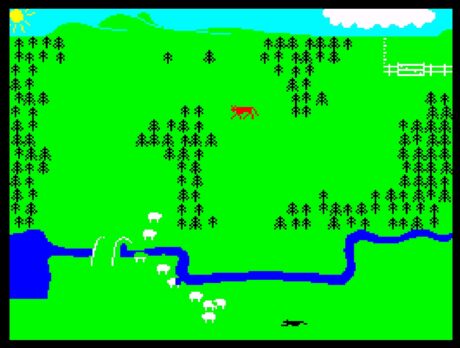












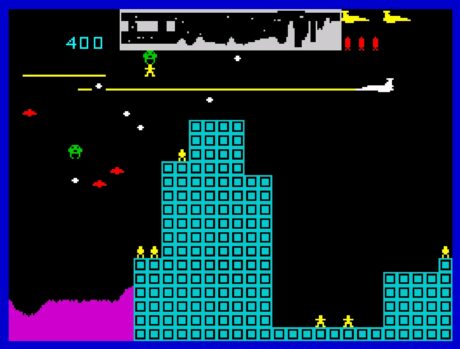




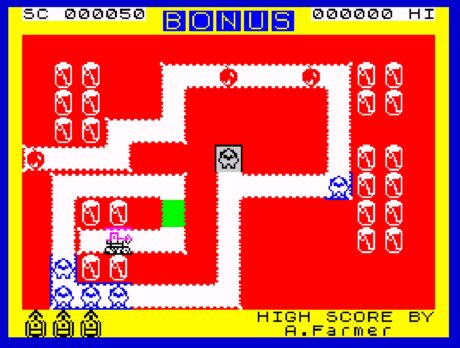



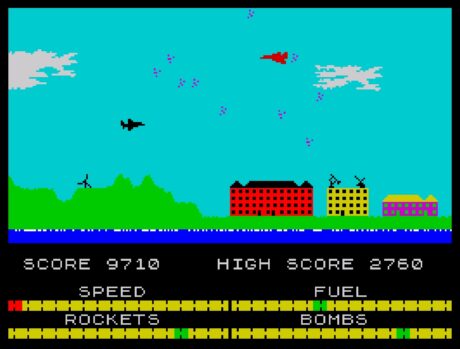

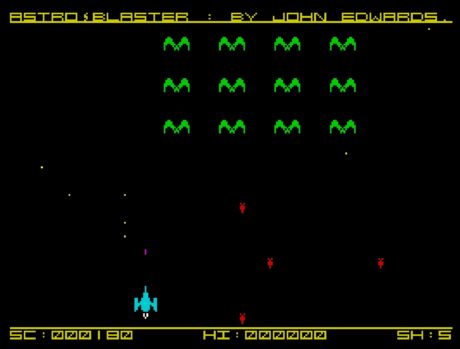









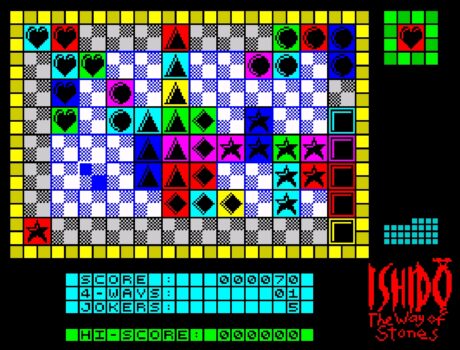








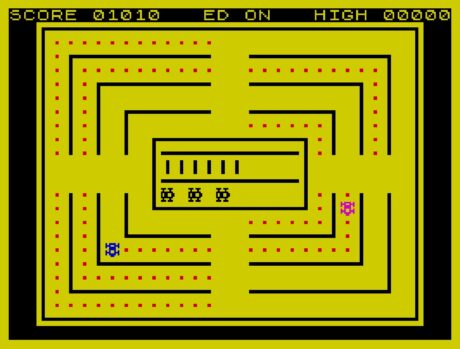
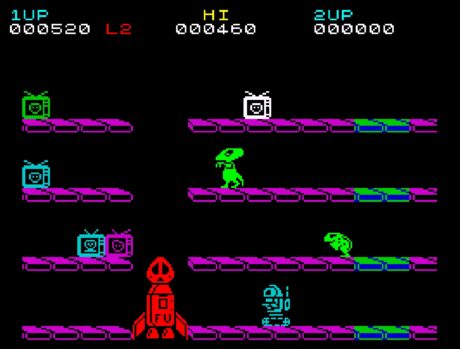








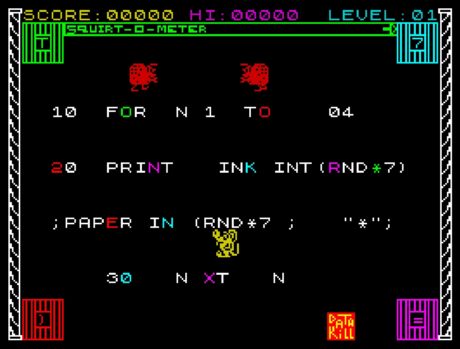






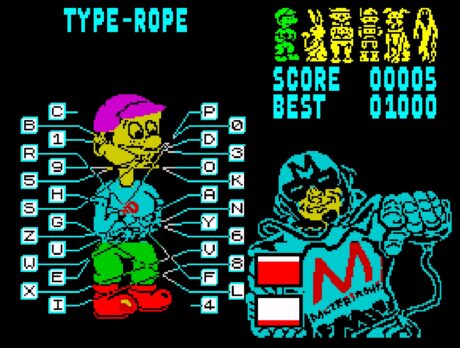



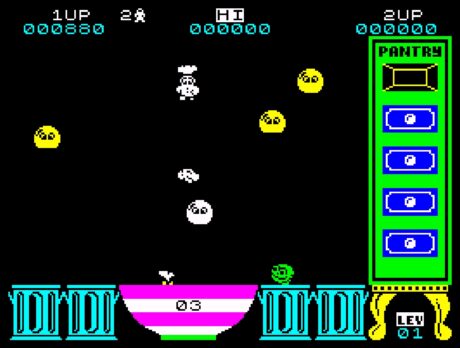




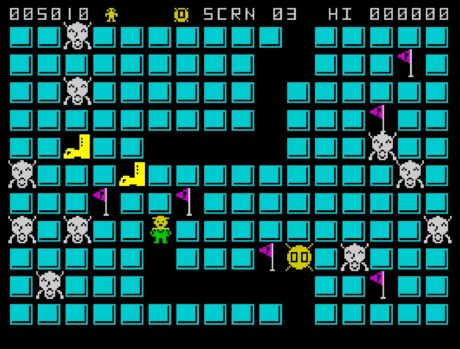













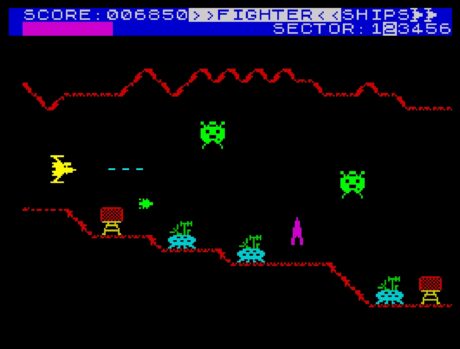

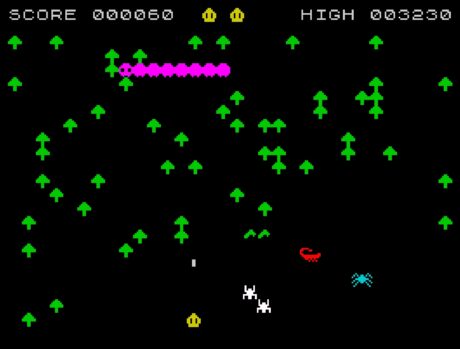
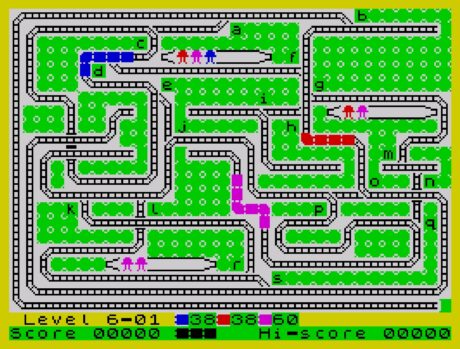

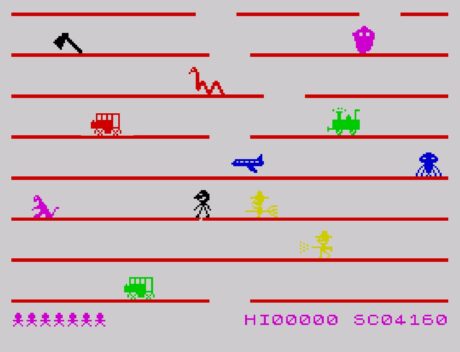








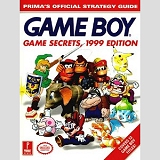


The very first computer I played was my mate’s 16k Spectrum and, yes, it must have been around 1983. I can remember Horace Goes Skiing and Froggy but the main game we played was Jetpac. I assume that must be in the top 50.
I was surprised to see that I’d played a lot of these without knowing they were 16k games. Great article. Really interesting stuff about Type-Rope and glad to see Tranz-Am (the only good Ultimate game) get a decent position on the list.
This is great, thanks Stu! The RSS links are wildly broken, but that’s internet.
I’d forgotten about Androids, a massively underrated game. Full-screen super-fast scrolling in 1983!